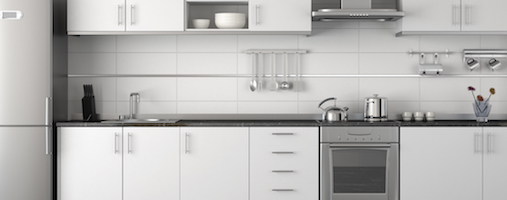With kitchen appliance handle design trending away from the contoured look that was favored by OEMs for more than a decade to a more commercial-kitchen, almost industrial aesthetic, different approaches to handle manufacturing are required.
Whereas tubular hydroforming and tubular stamping were good fits for creating gently curved metal appliance handles that were lightweight and had minimal numbers of parts, the current trend among brands such as KitchenAid and Maytag is to create simple geometric handle assemblies. While these handles can have more parts, such as cast brackets and end caps, they involve simpler manufacturing processes and can be more expensive than hydroformed or stamped handles — mainly due to the higher component cost required to achieve the desired appearance.
As kitchen appliance designers continue to move in this direction — and to innovate in the field of kitchen appliance handle design, period — it’s important to find a handle manufacturing partner that knows the industry and that has a range of manufacturing capabilities at its disposal. That way, engineers and supplier can work together to realize designs in the most cost-effective manner possible.
Here are the main factors we evaluate with OEM designers when we begin discussing a new kitchen appliance handle project at Mills Products — as well as some more details about some of the latest trends we’ve noticed in kitchen appliance handle design.
Appliance Handle Shapes
As mentioned above, higher-end appliance handle design is favoring simple shapes that don’t require complex metal forming processes.
However, some of the value brands on the market, such as Amana and certain GE kitchen appliances, still feature gradually rounded tubular shapes that can be made with roll forming, a process for turning flat metal stock into tubular parts.
Also, some of the features that brands rely on to distinguish their upmarket kitchen appliance handles in the consumer market (such as knurling or finger grips; see below) can be added to an otherwise simple tubular workpiece via hydroforming, a process with minimal tooling costs relative to stamping, making it cost-effective for mid-sized runs.
Appliance Handle Materials
While kitchen appliance handle shapes are changing, stainless steel remains the material of choice.
What is shifting, however, is the trend toward combining core stainless steel pulls with components made from other materials in order to fashion appliance handle assemblies. For example, the KitchenAid Black Stainless Steel line of major kitchen appliances combines a stainless steel pull with chromed brackets and red metal medallion endcaps held together with visible stainless-steel screws.
Appliance Handle Features
As OEMs gravitate toward more of a commercial look for home kitchen appliances, they are using simple tubular handles that attach to doors with prominent, angular brackets. This puts more and more emphasis on those brackets, which can me made more prominent by varying colors, shapes, textures, and modes of attachment.
Endcaps, for instance, are important functional and aesthetic components. They are generally cast and have to be held to exacting standards when it comes to finish and fit — particularly for upmarket brands.
Appliance Handle Finishing
Most brands are maintaining a traditional linear brushed stainless steel look for the main tubes of their commercial-kitchen-styled handles — the No. 4 brush pattern seen on a lot of kitchen, restaurant, and food processing equipment.
Some, though, are moving away from this prevalent finishing technique. KitchenAid, for instance, has incorporated a textured knurl — a sort of crosshatching that, according to Jason Tippetts, Lead Designer at KitcheAid, delivers “some excitement and attention to the craft that it took to put [it] together. . . You expect it to have a certain feel. And then, when you touch it, you actually get another, new experience, which is hopefully a texture that you weren’t expecting.”
Many lower-end kitchen appliances, however, come in black, white, and stainless steel options. This means that separate handle finishes that will work with these different options for the main appliance bodies have to be developed. Solid colors such as the typical black and white are usually achieved through powder coating.
Appliance Handle Fit & Function
One of the most challenging aspects of production is verifying that the manufactured assembly will fit and function properly. This requires precise measurement, physical evaluation, and the right mounting system.
For most higher-end kitchen appliance brands, it’s imperative that handles fit exactly since gaps between components signify lack of quality. Meanwhile, the attachment points for handles also need to be robust enough that the pulls will be able to endure significantly more than the anticipated force — and do so repeatedly. This usually comes down to a thorough mechanical evaluation of the primary joint that will carry the load.
Designers and Manufacturers Working Together
Getting a grip on all the factors involved in appliance handle manufacturing is a lot easier if you are working with an experienced partner. They’ll be able to advise on what can and can’t be done using available manufacturing techniques and can help steer you toward the most cost-effective solution.
Moreover, as kitchen appliance handles move toward simpler designs that paradoxically involve more parts and processes in their assemblies (e.g., casting, hydroforming, roll forming, and even stamping), it’s important to work with production experts who know all the processes that will be involved in manufacturing your products. They’ll not only be able to handle the manufacturing; they’ll also have the capabilities to coordinate assembly.
If you need a full-service appliance handle manufacturing partner, look no further than Mills Products. Contact us today and we’ll be happy to work with you to determine the best way to realize your design.


